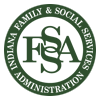- Children play with crafts at the home daycare run by Janna Rodriguez, who has spent more than a decade in child care.
Photo provided by Janna Rodriguez.
For the more than 850,000 Indiana children who are infants through 9 years old, only 763 licensed child care centers exist to take care of them when their parents cannot. Because of this, a CNBC study ranked Indiana almost at the bottom for quality of life, with the worst access to child care in the country.
At the beginning of the 2025 legislative session, Indiana Senate Democrats prioritized child care in their agenda, writing that they hoped to fully fund the Child Care Development Fund(CCDF), a child care subsidy for low-income families. But with the session ending April 24, their goal did not come to fruition in the supermajority Republican General Assembly.
Indiana’s problem with child care
A 2024 study by the Indiana Chamber of Commerce found that over half of Hoosier parents miss work or class because they cannot find child care. Absenteeism and employee turnover caused by this struggle creates an estimated $3.05 billion in losses for Hoosier employers each year.
Vanessa Green Sinders, president and CEO of the Indiana Chamber, told TheStatehouseFile.com in January that child care desserts like Indiana deter potential workers from coming to the state.
Vanessa Green Sinders, Indiana Chamber of Commerce president.
Photo provided.
“We are such a great state to do business in, and we have so much economic development going on, … but that enthusiasm and that economic development is going to take more workforce,” Sinders said.
The Indiana General Assembly did not allot the appropriate amount of money in the state budget to give Hoosiers universal, affordable child care through the CCDF, On My Way Pre-K or any other program. Instead, lawmakers wrote piecemeal legislation that addressed small parts of the larger problem.
Legislation
House Bill 1253 was signed into law by Gov. Mike Braun on May 1.
During a House meeting late in the legislative session, which ended April 24, bill author Rep. Dave Heine, R-Fort Wayne, said the Senate amended the bill to no longer require children who receive child care at a school to be a child of an employee. The Senate also changed the bill to allow multi-site child care centers, like a YMCA, to be able to operate under one license.
“It really will make it easier for them to expand but also, importantly, maintain the ability of the state to, you know, inspect and hold accountable those individual sites without jeopardizing the functioning of the entire enterprise,” Sam Snideman, vice president of government relations for United Way of Central Indiana, told TheStatehouseFile.com.
Sam Snideman, vice president of government relations for United Way of Central Indiana.
Photo provided: https://www.uwci.org/executive-team
The most important Senate amendment, in Heine’s opinion, was the addition of language that allows in-home child care centers to continue operation as class two structures as long as they are licensed in that category before July 1.
“This is very important language that was added because right now, we have 43 child care facilities providing child care to approximately 800 children that could be at risk of closing down if we did not add this language,” Heine said in the House meeting.
Senate Bill 463, also signed by Braun May 1, would give a tax credit to employers who offer near or onsite child care to their employees.
Snideman said adding this option would make employers who opt into the tax credit more competitive in Indiana’s job market because employees with kids might choose to work there for child care.
The new law will also expand the Micro-Facility Pilot Program, a project that allows existing child care centers to open small, non-residential ones that serve three to 30 children.
Sinders said the Indiana Chamber supported SB 463 and HB 1253 because they attempt to make child care more affordable and accessible in Indiana.
House Bill 1248, signed into law April 10, sets aside CCDF funds for foster families who receive last-minute placements.
“We don’t want to disadvantage those folks who are doing, you know, really important work or, you know, quite honestly disrupt the care for kids who are already facing tremendous challenges.” Snideman said.
House Bill 1102, another child care bill that reached the governor’s desk, receiving his signature April 3, will allow schools to enter contracts with religiously affiliated, nonprofit pre-K sites that offer child care. Snideman said this will create more potential providers for Hoosier families.
Snideman believes the reason Indiana has not invested fully in CDDF and other government-funded child care initiatives is because the issue is so broad. But both he and Sinders believe there’s room for optimism.
“I think about it from a positive perspective,” Sinders said. “The legislature is willing to continue to work on this issue and continue to try to make progress. … Every bite at the apple helps get you to the solution.”
Snideman is even more confident about the possibility of universal child care in Indiana’s future.
“We are committed to expanding opportunities for Hoosiers in this space,” he said, “which means we will be committed to this long, incremental process of us getting to a place where eventually, you know, every family in our state who wants and needs to send their kids to pre-K or to child care will have that opportunity.”
TheStatehouseFile.com is publishing this article as part of the Statehouse Reporting Project, a collaborative effort by collegiate journalism programs operating in statehouses across the country.





